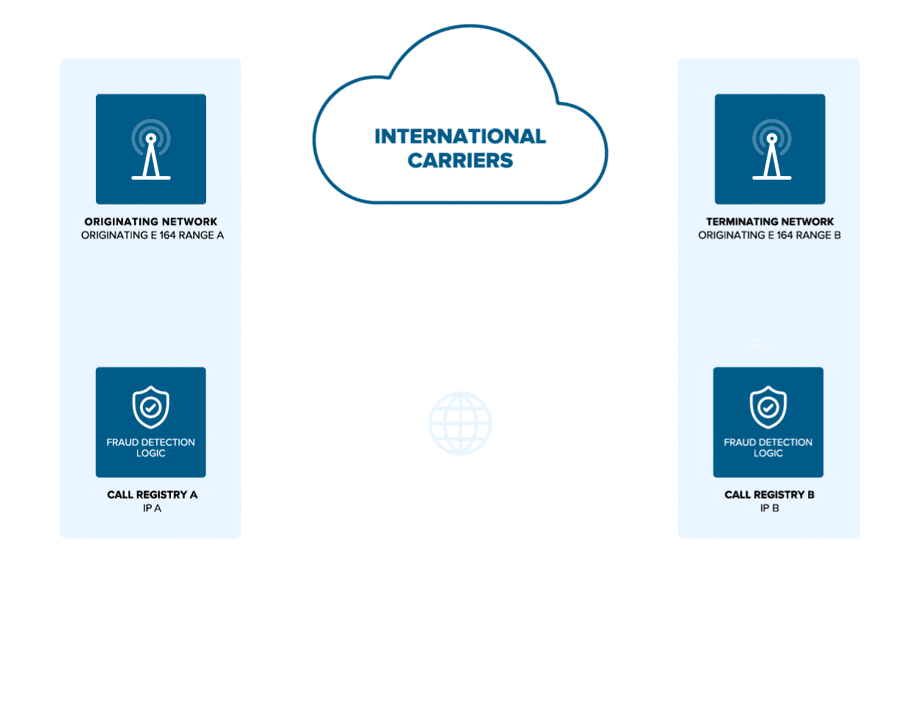
Higher the Traffic, Higher the Fraud - Telecom fraud prevention
Table of contents:
- What is Telecommunications Fraud?
- Types of Telecommunications Fraud Schemes
- Telecommunications Fraud in the UK - New levels of sophistication
- Traditional Telecom Fraud Technology - Protection, not prevention
- Community-based Approach to Telecom Fraud Prevention
- Taking a Cue From the Banking Industry For Telecom Fraud Prevention
- Telecom Fraud Prevention With AB Handshake - How it works
- Telecom Fraud Prevention With AB Handshake - How it works
- Community - A Key Factor For Telecom Fraud Prevention
- Integration - Fast, Cost-effective, Seamless
- Telecom Fraud Prevention - A global fraud-free community
What is Telecommunications Fraud?
Before we get into the details about what kind of fraud threatens the telecom industry and how telecom fraud prevention solutions can stop it, let's quickly define what telecom fraud is.
Telecommunications fraud is an attack on telecom services with the goal of stealing money from the operators, their clients, or enterprises.
Many of you have likely had personal experience with robocalls. We hear a recorded voice on the other end of the phone, lose our patience and quickly hang up.
Robocalls may seem like a relatively innocent annoyance at first, but attacks from this simple fraud scheme, alone, add up to $0.9 billion in losses for the entire industry each year.
Other sophisticated fraud schemes are outsmarting telecom fraud prevention technology every day.
These include Wangiri, PBX Hacking, Call Stretching and more. It's time to look at each of these, in detail.
Telecommunications Fraud in the UK - New levels of sophistication
The most popular target for phone fraud is the United Kingdom. According to TechRadar, 15% of fraudulent traffic in 2019 was aimed at British phone numbers. According to TechRadar, the reason for this is the UK's regulation of phone numbers.
The ease at which anyone can buy an '07' number along with high mobile termination rates make it hard for telecom fraud prevention solutions to distinguish between legitimate numbers and fraudulent ones.
By mid 2020, COVID-19 related fraud in Great Britain, alone, had amounted to £1.6 million.
The pace and sophistication of fraudsters has left telecom companies on their back foot for decades, exposed to enormous financial and reputational losses each year.
With such sophistication, what can we do to ensure operators and their customers are protected from telecommunications fraud? As I mentioned above, a telecom fraud prevention system via call validation is the only way to mitigate this problem.
Traditional Telecom Fraud Technology - Protection, not prevention
Telecom service providers and government institutions have been in the fight against telecom fraud for decades, offering telecom fraud prevention solutions for operators that stop most, but not all, fraud attacks.
Recent legislation regarding fraud mitigation in telecommunications includes the TRACED anti-robocall act in the US. However, since there are such large profits in fraud, most scammers have ignored it. They push ahead.
Another recent milestone for fraud mitigation in telecommunications was on June 30th, 2021 - the deadline for operators to integrate the new STIR/SHAKEN protocol or an alternative telecom fraud prevention platform into their existing systems.
However, many operators implementing the STIR/SHAKEN protocol have faced problems with integration expenses and compatibility (it only works with SIP networks).
Additionally, operators face problems with the functionality of the protocol - for example, it cannot 100% reliably identify which is a robocall and which is not. This has left operators unsure of which calls to block and which calls to let through.
Until recently, there has been no way to ensure that telecom operators are completely protected from telecommunications fraud.
To be sure operators are protected from all fraud attacks, a new approach to telecom fraud mitigation strategies is necessary. And, luckily, we are just in time.
Using technology akin to the SWIFT system developed for the banking and international finance sector in the 70s, the telecommunications industry now has hope that we'll be able to operate without fraud, once and for all.
Community-based Approach to Telecom Fraud Prevention
Traditional telecom fraud prevention systems use reactive techniques with each of their operators that collect their own data and analyze calls on their networks.
This means that they can gain insight only on the calls taking place on their networks, but nowhere else.
Because telecom fraud schemes can easily route a single call through many networks, there is a lot of data these systems don't detect.
The new idea for telecom fraud detection is that via collaboration, multiple operators can exchange call data to prevent any fraudulent call from connecting.
Such collaboration can facilitate a community of operators that can proactively co-operate to monitor and validate calls over multiple operators. This is much like the SWIFT system does for banks sending and receiving payments around the world.
Taking a Cue From the Banking Industry For Telecom Fraud Prevention
The solution to telecom fraud prevention was, to an extent, discovered by the Banking industry back in the 1970s.
In the case of SWIFT, Bank A knows how much money they are sending to bank B and which account it's meant for. At the same time, Bank B knows who sent the funds and which account it's meant for.
Both the sending and receiving banks know the details of the transaction - agreeing on the details of this method is what led to the Society for Worldwide Interbank Financial Telecommunication (SWIFT) in 1973. There is a lot of overlap between an international phone call and an international bank transfer.
- Both involve an A party that initiates the transaction and a B party receiving it.
- Both involve two companies, in different countries, abiding by common protocols with no control over each other.
- Both involve an active A party and a passive B party, but the B party can reject the transaction.
- Both involve forms of messaging: signaling is a fundamental component of telecom operations. Banks and financial service providers also use communication methods that work at the speed of light.
Nadejda Paperneia, CEO of AB Handshake, summarizes it:
Instead of altering the networks themselves, two communications providers can simply use the internet and secure messaging protocols to inform each other about the traffic that is meant to be passing between them.
This communication should be separate and parallel to the call itself because avoiding the need for a network upgrade will greatly reduce the time and cost of implementing the solution.
If the A and B party operators have agreed on this secure communication channel to validate every call, then no calls can be manipulated as they transit across intermediaries.
This is because the inconsistency will be obvious to the operators at the source and destination. They will reject the call like a bank rejects a suspicious transfer.
Taking these ideas into consideration, the team behind telecom fraud management company AB Handshake set out to create the 'SWIFT for telecommunications' - a 100% effective telecom fraud management solution.
The outcome is exactly what they predicted.
Telecom Fraud Prevention With AB Handshake - How it works
The key feature of the AB Handshake telecom fraud prevention solution is that it stops 100% of all voice fraud for all participating partners. This is unprecedented in the world of voice fraud technology.
The key to providing this guarantee is in its real-time call validation between the originating and terminating networks.
Here's how the AB Handshake fraud prevention solution works (see image below):
- Every time a call is initiated, the call details are sent to a Call registry
- This Call registry uses the E.164 numbering plan to route a validation request
- This validation request reaches the terminating network before the call
- Cross-validation of the call details from both networks allows the detection of any manipulation.
- When any manipulation is detected, there is only one reason for it - fraud - and the call is blocked in real-time.
- All communications carried out via HTTPS are performed with TLS encryption.

AB Handshake working scheme
Instead of retrospectively detecting fraud and then trying to prevent it from occurring again, operators within the AB Handshake community can interact with their partners to guarantee that the traffic between multiple parties' networks is all validated.
Most importantly, all of the above-mentioned fraud schemes (Wangiri, Wangiri 2.0, Call Stretching, PBX Hacking, etc.) and more can be detected and prevented in real-time.
This is the first time such comprehensive telecom fraud detection and prevention has been possible.
Community - A Key Factor For Telecom Fraud Prevention
AB Handshake is fully confident that this ecosystem will be safe from all voice fraud because of the real-time call validation between the originating and terminating networks performed by the system.
For this telecom fraud management solution to work optimally, as many operators as possible should collaborate. Each additional member strengthens the ecosystem and allows more calls to be validated.
AB Handshake guarantees that the community is 100% fraud-free because of this capability.
Adding more members is a priority. And because of the guarantee of being 100% fraud-free, AB Handshake is continuously taking on new operators to its ecosystem. It's a win-win situation.
In alignment with the urgent recommendations from the ITU CxO meeting 2023, AB Handshake's real-time call validation solution is at the forefront of addressing the critical fraud challenges highlighted. The ITU group pointed out the inefficacy of threshold rules and isolated solutions, emphasizing the pressing need for a global, cooperative approach to telecom fraud.
Read the ITU committee's suggestions for a safer telecom future.
Now, such a fraud management system in telecom wouldn't be practical, if it weren't cost-effective and easily integrated into the default settings of any network operator's current system.
Integration - Fast, Cost-effective, Seamless
The beauty of the AB Handshake telecom fraud management system also lies in its simplicity. It is cost-effective and compatible with any network operator's current system:
- Firstly, AB Handshake can address the entire landscape of operators because their solution is compatible with both IP and TDM networks.
- Secondly, with AB Handshake, call registries run on common-use hardware, meaning no additional investment is needed.
- The solution is installed within an operator's security perimeter, complying with their security and personal data processing stipulations.
In other words, any kind of operator business can take full advantage of this telecom fraud prevention solution.
As we mentioned above, this is new for fraud detection in the telecom industry because it has always operated on network-specific systems only.
Today, AB Handshake's mission is to make this fraud-free community global.
Telecom Fraud Prevention - A global fraud-free community
A global fraud-free community of network operators will not only eliminate fraud on all international voice traffic, but also protect customers from illegal robocalls and other annoyances.
AB Handshake telecom fraud prevention provides the technology to make this possible. Community membership is affordable for any operator in any part of the world.
To join the ecosystem and start protecting your business and your customers today, get in touch with us here. A member of our team will contact you today to answer any questions and walk you through the integration steps.
Even if your business isn't ready to start using a telecom fraud prevention solution, we welcome anyone interested in joining the life of our community. If you are interested in:
- Joining educational webinars on telecom fraud prevention
- Joining face-to-face meetings to discover more about telecom fraud prevention
- Learning about new fraud patterns being detected
Just get in touch.
We're waiting for you.
Subscribe to our Newsletter
Subscribe to our marketing material (newsletters and special offers). Unsubscribe at any time via footer link in emails you receive.
Please review our Privacy Policy